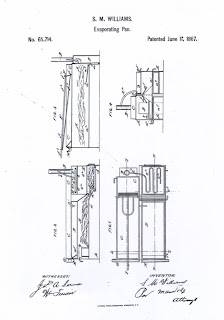Note: While this series of six blogs
will focus on patents from Pine Village, Rainsville, and Independence, Indiana,
several equally fascinating patents originated in other towns within Warren
County, Indiana.
As fewer
than a million gallons of sorghum syrup are produced annually in the United
States today, it is easy to forget that, in 1900, when the U.S. population was
only a fourth what it is today, more than twenty million gallons were produced.
Sorghum is a cereal grain that is harvested for human consumption in some parts
of the world. As it is free of gluten and full of nutrients, sorghum could enjoy
a comeback in the U.S. one day. Benjamin Franklin wrote about using the straw
for brooms, but not until a century later was sorghum widely cultivated in the
U.S. Page 62 of the Fourteenth Annual
Report of the Ohio State Board of Agriculture (1859, published in 1860)
announced that the state fair had witnessed “many samples of syrup of the
Sorgho, or Chinese Sugar Cane.” As late nineteenth-century homes had gallon
containers of sorghum syrup (a.k.a. sorghum
molasses) to pour on buckwheat pancakes, to sweeten baked beans, to make cookies,
and to flavor bread, there was widespread interest in techniques for boiling
the juice from the crushed sorghum stalks to transform into syrup.
 |
| Sorghum: An Important Crop in Samuel M. Williams' Day |
According
to page 32 of the Report of the
Commissioner of Agriculture for the Year 1867, 6,698,181 gallons of sorghum
molasses were recorded in the census for 1860. Indiana, Illinois, Iowa, and
Missouri were responsible for approximately half the total production in 1867,
when Samuel M. Williams, who lived on a farm just west of my hometown of Pine
Village, Indiana, invented an improved evaporator system to change sorghum
juice into “sirup,” as the word was often spelled back then.
 |
|
Sorghum
Mill for Mashing Juice from Stalks
Drawing
by Eric Sloane
In
Once Upon a Time: The Way America Was (1982)
|
If my
genealogical work is correct, Samuel was the grandson of two early Hoosiers.
Kenneth E. Kinman contributed this information to the Society of Indiana
Pioneers: Samuel Williams, who was born around 1788 in Charles County,
Maryland, was the eldest son of Jeremiah Williams, who was born possibly in the
1760s in Charles County, Maryland, and who died on the 31st of May in 1812 in
Franklin County, Indiana, where the family had moved after residing in Scott
County, Kentucky. In 1809, the same year that Abraham Lincoln and Edgar Allan
Poe were born, Samuel married Susanna Hackleman, who was born a daughter of
Johann Jacob Hackleman in South Carolina in 1787. The censuses of 1820 and 1830
recorded that Samuel and Susanna were living in Fayette County, Indiana. On the
8th of June in 1833, Samuel bought two hundred acres of land in Warren County,
Indiana (the county where I grew up on a farm). Four years later, he added
thirty-eight more acres. Although Samuel died on the 20th of March in 1839, his
widow, Susanna, whom some documents call Susan, lived for many more years. She
appeared in the censuses of 1840 and 1850 as a citizen of Warren County. She
then moved across the state border to Iroquois County, Illinois, where she was
buried.
 |
|
Patent
for Sorghum Juice Evaporator
By
Samuel M. Williams
Pine
Village, Indiana (1867)
|
I see an
eight-year-old Samuel listed in the 1850 census (taken in September of that
year), who is in Susanna’s household, where a daughter in her thirties was also
living. I must guess that Samuel is Susanna’s grandson. They lived in Pine
Township, which is immediately west of Pine Village and which includes
Rainsville. I am virtually certain that I have identified the correct person as
our inventor, but let me explain my slight hesitancy. The name “Samuel
Williams” was common in the 1860s; there were several men by that name in
Indiana. I believe that I can logically rule out the others and that Susanna’s
grandson is the Samuel Williams of our story.
 |
|
Samuel
M. Williams’ Patent
For
Sorghum Juice Evaporator
Reported
in Scientific American for June 29,
1867
|
If I am
right, Samuel was twenty-five years of age when he patented his evaporator
system. Let us get the gist of his invention. Essentially, Samuel has one
firebox to supply heat to three trays. When the sorghum juice has been reduced
a third of the way in one of the trays, it is conducted into a second tray,
and, when it has been reduced by a second third, it is finished in a third tray
that is steam heated just above the firebox. Samuel opens and closes dampers to
conduct heat from the fire to the tray of his choice.
Samuel also
patented a rake with a screen that slides along the edges of the trays in such
a way that it does not touch the unwanted sediment at the bottom of a tray but
merely skims any unwanted scum off the surface of the syrup.
As with any
patent about which not much can be known this many years later, I wonder if
Samuel built and sold any of his evaporators. Apparently, his invention was
novel enough to catch the attention of Scientific
American, the leading magazine of its kind, which listed his evaporator
patent. Other names associated with Samuel’s patent include witnesses William
W. Sale and George W. Wakeman.

No comments:
Post a Comment